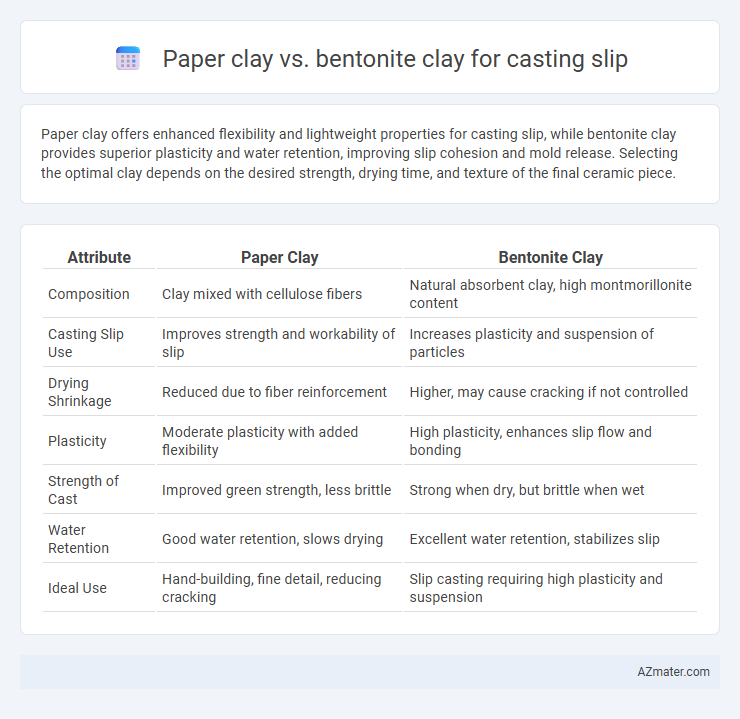Paper clay offers enhanced flexibility and lightweight properties for casting slip, while bentonite clay provides superior plasticity and water retention, improving slip cohesion and mold release. Selecting the optimal clay depends on the desired strength, drying time, and texture of the final ceramic piece.
Table of Comparison
| Attribute | Paper Clay | Bentonite Clay |
|---|---|---|
| Composition | Clay mixed with cellulose fibers | Natural absorbent clay, high montmorillonite content |
| Casting Slip Use | Improves strength and workability of slip | Increases plasticity and suspension of particles |
| Drying Shrinkage | Reduced due to fiber reinforcement | Higher, may cause cracking if not controlled |
| Plasticity | Moderate plasticity with added flexibility | High plasticity, enhances slip flow and bonding |
| Strength of Cast | Improved green strength, less brittle | Strong when dry, but brittle when wet |
| Water Retention | Good water retention, slows drying | Excellent water retention, stabilizes slip |
| Ideal Use | Hand-building, fine detail, reducing cracking | Slip casting requiring high plasticity and suspension |
Introduction to Casting Slip Clays
Casting slip clays like paper clay and bentonite clay serve distinct roles in ceramic casting processes. Paper clay, enhanced with cellulose fibers, offers improved strength and flexibility during drying, reducing cracking in delicate slip cast forms. Bentonite clay, rich in montmorillonite, acts as a powerful suspending agent that enhances the slip's plasticity and maintains particle suspension for smoother casting results.
What is Paper Clay?
Paper clay is a composite material combining traditional clay with cellulose fibers from paper pulp, enhancing its strength and flexibility when dry compared to bentonite clay. Unlike bentonite clay, which is a natural absorbent clay used primarily for its plasticity and water retention in casting slips, paper clay improves drying durability and reduces cracking in cast pieces. This makes paper clay particularly advantageous for intricate ceramic forms and repair in slip casting applications.
What is Bentonite Clay?
Bentonite clay is a highly absorbent, fine-grained clay composed primarily of montmorillonite, known for its exceptional water retention and plasticity in casting slip formulations. It improves slip suspension by increasing viscosity and preventing particle settling, making it essential for smooth, consistent ceramic castings. Compared to paper clay, which incorporates cellulose fibers for strength, bentonite clay enhances mold release and slip stability without altering the structural properties of the dried piece.
Key Properties: Paper Clay vs Bentonite Clay
Paper clay exhibits superior plasticity and enhanced drying strength, making it ideal for intricate casting slip projects requiring flexibility during shaping and reduced cracking upon drying. Bentonite clay offers high swelling capacity and strong adhesive qualities, providing excellent suspension and particle binding in casting slips but with less flexibility and a tendency to crack if dried too quickly. The choice between paper clay and bentonite clay depends on the specific casting slip requirements for workability, drying behavior, and final strength.
Workability in Casting Slip Applications
Paper clay improves casting slip workability by increasing slip plasticity and reducing shrinkage, resulting in smoother mold release and finer surface detail capture. Bentonite clay enhances slip viscosity and suspension stability, promoting uniform particle distribution and improved form consistency in cast pieces. Optimal casting slip formulations often combine paper clay's flexibility with bentonite's binding properties to balance workability and structural integrity during drying and firing.
Drying and Shrinkage Differences
Paper clay exhibits reduced drying shrinkage due to its fibrous cellulose content, which helps maintain moisture and minimizes cracking during the drying phase. Bentonite clay, high in montmorillonite, swells significantly when wet but undergoes substantial shrinkage and potential warping as water evaporates from the casting slip. Consequently, paper clay is preferable for casting processes requiring greater dimensional stability and less deformation in the drying stage.
Casting Slip Strength and Durability
Paper clay enhances casting slip strength by integrating cellulose fibers that reinforce the ceramic matrix, resulting in improved tensile strength and reduced shrinkage during drying. Bentonite clay offers excellent plasticity and suspension stability in casting slips but may cause brittleness after firing due to its high swelling properties. Combining paper clay with bentonite can optimize casting slip durability and strength, balancing flexibility with structural integrity.
Firing Results: Texture and Finish
Paper clay casting slips yield fired pieces with a smooth, lightweight texture and a slightly porous finish due to the organic fiber content burning out during firing. Bentonite clay casting slips produce fired surfaces with a denser, more vitrified texture and a glossy or semi-matte finish, attributed to its high plasticity and particle fineness. Paper clay's porous finish enhances surface decoration adherence, while bentonite's dense finish provides superior strength and water resistance in the fired castings.
Common Uses in Ceramics and Pottery
Paper clay is commonly used in ceramics for hand-building, adding texture, and improving the strength of greenware due to its fiber content, making it ideal for sculptural and complex forms. Bentonite clay is primarily incorporated into casting slips to enhance plasticity and suspension, which improves the slip's flow properties and reduces defects in mold-cast ceramic pieces. Both clays serve distinct roles in pottery: paper clay strengthens and allows for delicate construction, while bentonite optimizes casting slip performance for reproducing fine details in molds.
Choosing the Right Clay for Your Project
Choosing the right clay for casting slip depends on your project's requirements for texture and strength; paper clay, enriched with cellulose fibers, offers improved crack resistance and a lighter, more porous finished product ideal for delicate, sculptural work. Bentonite clay, known for its high plasticity and excellent suspension properties, enhances slip viscosity and adhesion, making it suitable for detailed molds and heavier, more durable castings. Evaluating the desired finish, drying time, and structural integrity will guide whether paper clay's lightweight durability or bentonite's binding strength best fits your ceramic casting needs.

Infographic: Paper clay vs Bentonite clay for Casting slip
 azmater.com
azmater.com